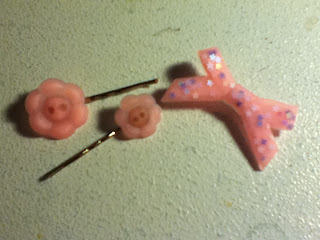I'm going to cover making the mold in this post and then add the instructions to a Silicone Rubber Blanket Mold Tab for quick reference. Then on Wednesday I'll be posting the resin project using the mold!
I found this cute bracelet at a discount shop and I was thinking of all the possibilities it had it as a mold so... I tried out ETI's Silicone Rubber to make a blanket mold of the bracelet!!
To start I covered my work space with wax paper.
To make a mold you need some EasyMold Silicone Rubber, the item you want to make a mold of, a measuring cup, stirring stick, and brush.
EasyMold Silicone Rubber is a 2 part mix. Part A is white and Part B is blue. These are mixed in a 1 to 1 ratio which means you need to mix equal amounts together.
Measure out some of Part A into your measuring cup...
Add an equal amount of Part B...
Mix thoroughly until a uniform color is reached. Be sure to get all of it from the bottom and the sides of the cup.
If you have difficulty measuring by pouring (this stuff is super sticky!) here's an alternate method of mixing.
You can use a disposable spoon: scoop up a spoonful and then level it with a popsicle stick and scrape it into your measuring cup. Do this for as many spoonful as you think you'll need.
Use a second spoon and stick to repeat with Part B making sure to add the same number of spoonfuls.
Mix the two parts together thoroughly...
until a uniform color is reached.
Once mixed, brush a thin layer of the mixture over the item you are making a mold of.
Once you have covered the item, spread the silicone about an inch around the inside and outside of the item- this will give you "handles" to make the mold easier to hold onto when filling with resin and to help when removing resin from the mold!
Let this layer of silicone rubber set up for at least an hour but not more than 12 hours.
Once the rubber sets for an hour or so you can peel the silicone rubber remnants out of your measuring cup and reuse the cup!
Mix up another batch of the silicone rubber and brush on a second layer an give it another hour or so...
Now mix up and brush on a third layer of silicone rubber and let it set for at least 12 hours
After the silicone rubber has set for at least 24 hours you can remove your item from the mold. Start by gently peeling the edges up to release it from your work surface.
Don't worry if there has been some seepage...
Use an exacto knife to make a slice along the mold cavity being careful not to cut the original item.
Then you can remove the original item from the mold! The mold needs to rest for another 24 hours to make sure that the silicone rubber has fully cured before using it to cast resin.
Now you are ready to create wonderful projects with your new mold!
Stay tuned for Part 2 on Wednesday which will show a project casting resin using the blanket mold!
























































